 Usborne encyclopedia of ancient Egypt
Usborne encyclopedia of ancient Egypt
Many books about ancient Egypt focus on Mummies and pyramids, which is a pity because, obviously, the history of an empire that lasted from 1096BCE to 30BCE is much richer than that. This book encompasses over 1000 years of history, not only focusing on the great Pharaohs, but what everyday life was like for the poorer members of Egyptian society. There are sections on everything from the Egyptian army to medicine to beauty care. There are plenty of links to useful websites, as well as a few timelines; one lists the pharaohs in chronological order, the other gives a chronological look at Egyptology and how its changed over the centuries. This is certainly one of the most through books on ancient Egypt we have in our collection, and a great book for school projects.
Stephen Biesty’s Cross-Sections: Castle
This book is a classic and for good reason. As a close look at castle life during the medieval period it’s yet to be bettered. The cross sections of the various parts of the castle are intricately detailed, with explanations of what’s happening in different parts of the drawing. They’re also quite funny; try to spot the sneaky spy and the castle inhabitants getting up to all sorts of things, many of them not exactly appropriate to the situation! The book manages to be both very informative and extremely fun. As well as the cross sections there are plenty of things like the feudal system, clothing and warfare. This is THE book to read if you’re at all interested in Medieval castles.
Terry Deary has been writing the Horrible History books for twenty years, and to his credit, they’re still as interesting and funny as they’ve ever been. Rather than focusing on one specific country, this is a look at the days in world history that have been particularly bloody. True to his established pattern, he doesn’t just stick to Western History; he also looks at the Sepoy and Boxer rebellions, as well as the Battle of Isandlwana. He also isn’t biased towards any particular group; everyone involved has their savagery discussed. It’s a great book, even by Terry Deary’s high standards, and well worth reading if you like your history both balanced and gory.
Bones never lie: How Forensic science helps solve history’s mysteries
One of the strangest parts of learning about history is how evolving scientific techniques of the present help us better understand the mysteries of the past. Forensic science is used to solve modern day murders, but it also has its uses in working out just what happened. For example, did Napoleon die of natural causes or was he murdered? Did the Grand Duchess Anastasia survive the massacre of her family by Communists? This book works hard to debunk various theories and explains the science behind each of the conclusions. But it also takes the time to look at each of the other theories in turn, and treats each one with equal weight.





















